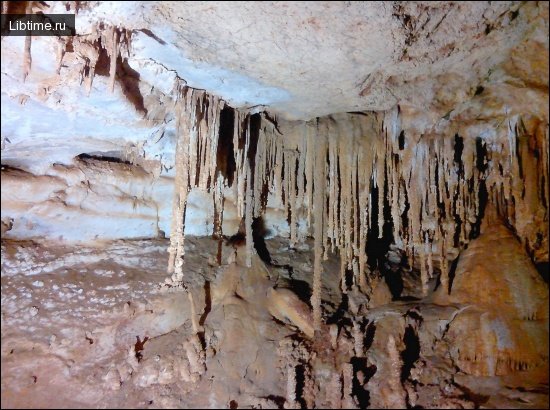Stalagmites
Stalagmites constitute the second large group of nalemic formations. They are formed on the floor of karst caves and usually grow towards stalactites.
Drops falling from the ceiling gouge out a small (up to 0.15 m) conical-shaped hole in the sediments of the cave floor. This hole is gradually filled with calcite, forming a kind of root, and the stalagmite begins to grow upwards. 
The size of stalagmites
Stalagmites are usually small in size. Only in some cases they reach a height of 6-8 meters with a diameter of the lower part of 1-2 meters. The world's largest stalagmite with a height of 63.2 m was found in Martin Cave (Cuba).
The second place is occupied by a stalagmite in the Krasnogorskaya cave (Czechoslovakia), its height is 32.7 m. In the areas where they connect with stalactites, calcite columns, or stalagnates, of the most varied shape appear. Particularly beautiful patterned or twisted columns.
Form stalagmites
Depending on the shape of stalagmites have many names. There are conical stalagmites, pagoda-shaped, palm, stalagmite sticks, corallites (tree-shaped stalagmites that look like coral bushes) and others.
The shape of stalagmites is determined by the conditions of their formation and, first of all, by the degree of watering of the cave. Very original stalagmites, which have the form of stone lilies in the grotto Iveria Anakopi cave.
Their height reaches 0.3 meters. The upper edges of such stalagmites are open, which is connected with splashing of water drops falling from a great height and accumulation of calcium carbonate on the walls of the formed hole. Interesting are stalagmites with rims resembling candlesticks (Tbilisi grotto of Anakopi cave). The rims are formed around periodically flooded stalagmites.
There are eccentric stalagmites. Their curvature is often caused by slow movement of the scree on which they are formed. In this case, the base of the stalagmite gradually moves downward, and drops falling on the same place curve the stalagmite in the direction of the top of the scree.
Such stalagmites are observed, for example, in the Anacopia Cave.
Structure of stalagmites
Stalagmites are characterized by a layered structure. In the transverse section, concentrically arranged white and dark layers alternate, the thickness of which varies from 0.02 to 0.07 mm. The thickness of the layer around the circumference is not uniform, because the water falling on the stalagmite spreads unevenly over its surface.
Sometimes stalagmites in section are very beautiful. 

White layers are characterized by crystalline structure and perpendicular arrangement of calcite grains to the surface of layers. Dark layers are amorphous, their crystallization is prevented by the presence of colloidal iron oxide hydrate.
At strong magnification in the dark layers the alternation of many white and dark very thin layers is revealed, which indicates multiple changes during the year in the conditions of infiltration of infiltration water.
The strict alternation of white and dark layers in the cross section is used to determine the absolute age of the stalagmites, as well as the underground cavities in which they are formed. The calculations yield interesting results.
For example, the age of a stalagmite from Kizelovskaya cave (Middle Urals), which reaches 68 cm across, was determined to be 2500 years (Maksimovich, 1963). The age of stalagmites from some foreign caves, determined by semiannual rings, was 600,000 years. (According to the research of F. Vitasek, in the Demenov caves in Czechoslovakia, a stalagmite of 1 mm is formed in 10 years, and a stalagmite of 10 mm - in 500 years).
This interesting method, which is becoming increasingly widespread, however, is still far from perfect and needs to be refined. In the longitudinal section of the stalagmite consists as if of many thin caps, put on each other. In the central part of the stalagmite, horizontal calcite layers fall sharply downward toward its edges.
Growth of stalagmites
The growth rate of stalagmites varies greatly. It depends on the air humidity in the cave, its circulation peculiarities, the amount of solution inflow, the degree of its concentration and temperature regime. As observations have shown, the growth rate of stalagmites varies from tenths to several millimeters per year.
Of particular interest in this regard are the works of Czechoslovak researchers who applied radiocarbon method to determine the age of karst formations. It was found that the growth rate of stalagmites in the caves of Czechoslovakia is 0.5-4.5 cm per 100 years (G. Franke).
In the long and complex history of the formation of natellite formations, epochs of material accumulation may alternate with periods of dissolution.
Related article: Stalactites.


